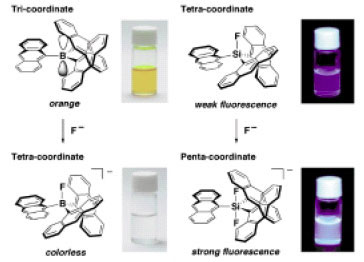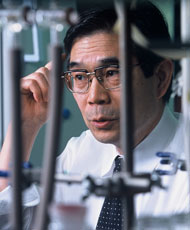Materials Science, Molecular Science, and "Elements Science"
- Creation of New Functional Materials by Synthetic Chemists -
Chemistry is a central, useful, and creative science, and everything around us is made of chemicals.
The Kyoto University COE (Center of Excellence) project in chemistry, entitled "Elements Science", started in 2000 is aimed at creation of new functional materials, especially organic and inorganic frameworks, which feature the characteristics of particular elements. Our concept of "Elements Science" constitutes the basis for the widely accepted "Molecular Science" and "Materials Science", since materials are generally composed of molecules, which in turn are made of atoms of individual elements. Thus, it is the properties of key elements that characterize the primary properties of materials. Some new molecules and materials have been created by ten research groups in this COE project, which would provide the next generation of electronic, optical, and magnetic devices. Representative examples are as follows.
Tamao group as project leader has prepared certain silicon-containing cyclic molecules called siloles that have a high electron-accepting properties. These new molecules exhibit the best electron-transporting properties for electroluminescent devices, being applicable to large-area flat panel displays as an alternative to liquid-crystal displays. Tamao group has also demonstrated a new concept that photophysical properties of boron or silicon-containing pi-conjugated systems can be controlled by the coordination state change of the element, as exemplified by a dramatic color change or an increase in the fluorescence by coordination with a fluoride ion (see Figure).
In an elemento-organic material field, Prof. Koichi Komatsu prepared new carbon nano-clusters C120 and C180 from C60 by a mechanochemical solid-state reaction for the first time, which are candidates for future molecular electronics. Prof. Tamejiro Hiyama and Prof. Norihiro Tokitoh are very active in creation of novel molecules containing main group elements, such as boron-silicon containing bimetallic synthetic reagents and a germanium containing naphthalene, respectively.
In an elemento-inorganic material field, Prof. Teruya Shinjo created submicron nickel-iron permalloy dots with a spot of perpendicular magnetization at each center of the dots, which would be useful for the next generation high-density magnetic recordings. Prof. Mikio Takano has been developing a new science of superconducting transition metal oxides. Prof. Toshinobu Yoko is an expert in creation of new photonic tailor-made glasses.
In a molecular-assembly field, Prof. Gunji Saito has created some sulfurcontaining organic super-conducting materials, in which weak sulfur-sulfur interactions play a key role. Prof. Yukio Sugiura has been modifying DNA molecules based on the zincfinger proteins. Prof. Naoki Sato is analyzing electronic structures of molecular aggregates by the inverse photoemission spectroscopy (IPES).
These examples clearly demonstrate that synthetic chemistry based on the "Elements Science" is the most fundamental discipline directly correlated with the core science and technology such as information-technology, environment technology, nano-technology, and biotechnology.

Photophysical properties control based on the coordination number of the main group element.

Kohei Tamao
Born in 1942.
Graduate of the doctoral program, Graduate School of Engineering, Kyoto University
Ph.D., Kyoto University
Professor and Director, Institute for Chemical Research, Kyoto University
"We synthetic chemists are the only ones capable of creating useful molecules that have never existed before."
It saddens Prof. Tamao that in recent years people have begun to associate negative images such as environmental pollution with the word like "chemicals." His voice becomes stronger as he says that he wishes the benefits of chemistry were more widely known. He points out that organic silicon compounds, his field of specialization, are chemicals that play a very familiar role in our lives. We are in contact with them every day without realizing it, in forms ranging from cosmetics to electronics. "When a new organic compound is created the most amazing things become possible, one after another," says Prof. Tamao. As he laughs impishly, it seems as if a flame of creative energy more powerful than the magic spell of the most brilliant wizard is quietly burning behind his eyeglasses.

